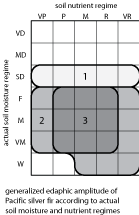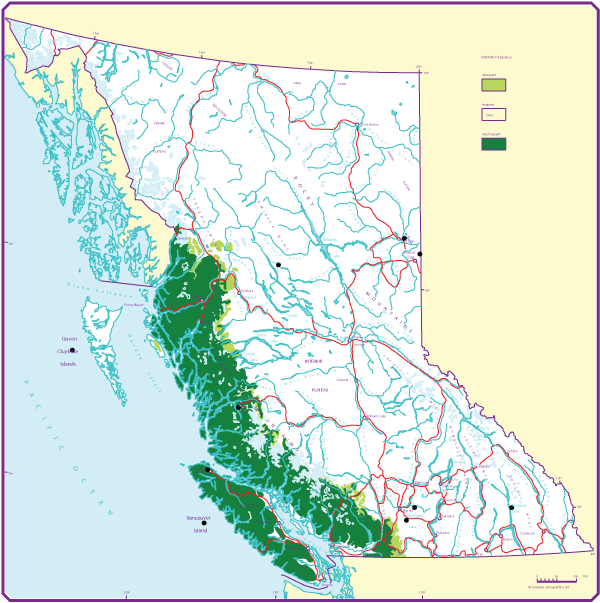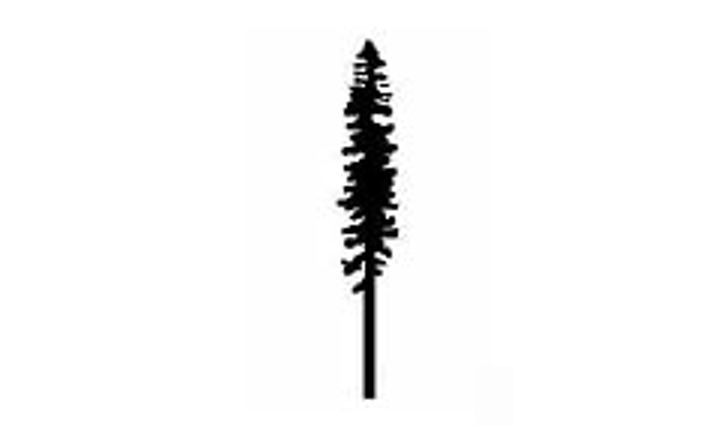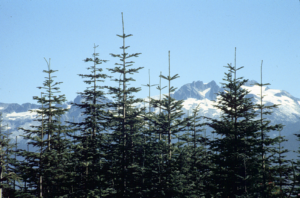Amabilis fir
On this page
Geographic range and ecological amplitudes
Description
Amabilis fir, also known as Pacific silver fir, is a medium- to large-sized (exceptionally >70m tall), evergreen conifer, at maturity with a low-taper stem, a narrow symmetrical crown, with lateral branches perpendicular to the stem and light gray bark becoming scaly and grooved with age. It is a valuable timber species that is marketed with western hemlock. Its light-coloured wood, without odor, gum, and resin, is typically used for construction.
Geographic range
Geographic element:
Distribution in Western North America:(north) and central in the Pacific region; (central) and south in the Cordilleran region
Ecological amplitudes
Climatic amplitude:
maritime subalpine boreal - (wet submaritime cool temperate) - wet cool and cold mesothermal
Orographic amplitude:
submontane - montane - subalpine
Occurrence in biogeoclimatic zones:
hypermaritime - maritime - submaritime MH, (northern wetter submaritime ICH), wetter hypermaritime - maritime - submaritime CWH
The summers where Pacific silver fir grows are never hot, and the winters are rather mild (monthly mean January temperature may be as low as -10 C in the MH zone). If occasionally the absolute minimum temperature drops as low as -35 C, Pacific silver fir suffers frost damage to branches and sometimes substantial parts of the crowns die. Such damage is common especially near the timber line, which for Pacific silver fir is about 150m lower than that for mountain hemlock, subalpine fir, and whitebark pine. It never grows in krummholz form. Towards warmer climates, Pacific silver fir is restricted to sites with cooler local climate.
Edaphic amplitude

Range of soil moisture regimes:
(slightly dry) - fresh - moist - very moist - (wet)
The water demand of Pacific silver fir is probably the largest for any evergreen tree in British Columbia. Thus, it grows in regions with the mean annual precipitation over 2500 mm (on the wettest areas of Vancouver Island, even as high as 6650 mm). It will also occur in drier regions with the mean annual precipitation as low as 1900 mm and shorter growing season, if a substantial part of annual precipitation is in the form of snow, that slowly melts during spring and early summer.
Range of soil nutrient regimes:
very poor - poor - medium - rich - very rich
Field studies indicate that Pacific silver fir is more vigorous on calcium- and magnesium-rich soils derived from basaltic or limestone parent materials. Nitrates appear to be a better source of nitrogen than ammonium compounds as indicated by the Moder (Mull) humus formation on the most productive sites.
Tolerances and damaging agents
Root system characteristics
Pacific silver fir develops a taproot system in well drained soils; a relatively flat, plate-like root system is formed in poorly drained soils. Fine roots occupy predominantly surface organic layers and are intensely mycorrhizal (Cenococceum graniforme).
| Tolerance to | Tolerance class | Comments |
|---|---|---|
| Low light | H | One of the most shade tolerant species. |
| Frost | M | Frost resistance of roots is very low, so heavy accumulations of snow are required to protect them from freezing. |
| Heat | L | Protection-requiring on warm and dry sites. |
| Water deficit | L | Protection-requiring on dry and warm sites. |
| Water surplus | H | Very frequent on very moist, infrequent on wet sites. |
| Nutrient (mainly N) deficiency | H | Frequent in acid, very poor soils. |
| Damaging agent | Resistance class | Comments |
|---|---|---|
| Snow | H | Heavy snowpack-tolerant. |
| Wind | M | Low resistance when exposed by heavy partial cuts. |
| Fire | L | Not a major concern in cool and wet climatic conditions. |
| Insect | M | Balsam woolly adelgid, western hemlock looper, western balsam bark beetle. |
| Fungi | L | Not a major concern in high-elevations; laminated root rot, Indian paint fungus. |
Associated tree species and successional role
Pacific silver fir grows in all seral stages and in combination with one or more tree species; pure old-growth stands are not rare but not very common. It is present as a major or minor species in early, mid-, and late stages of secondary succession; a major component in old-growth stands in the wetter CWH subzones and MH zone.
| Associated tree species |
Occurance class | Major area of occurance |
|---|---|---|
| Mountain hemlock | H | The most common associate in MH |
| Western hemlock | H | The most common associate in wetter CWH |
| Alaska yellow-cedar | M | Montane CWH, MH |
| Western redcedar | L | Wetter CWH |
| Engelmann spruce | L | Wetter submaritime CWH, submaritime MH |
| Common douglas | L | Southern montane CWH |
| Grand fir | L | Wetter submaritime CWH |
| Subalpine fir | L | Wetter submaritime CWH, submaritime MH |
Genetics and notes
Genetics
Despite its extensive range, Pacific silver fir is not a highly variable species. Some evidence from field studies on young trees suggests that Pacific silver fir may hybridize with grand fir or subalpine fir; however, such hybrids have not been described (aforementioned observations were made in the Fraser, Skagit, and Skaist River valleys). High-elevation provenances burst buds earlier in low elevation, common garden studies (Worrall, unpublished data).
Notes
Pacific silver fir is a very productive species on a wide range of sites except on warm and water-deficient ones. Its productivity results from large leaf biomass, shade tolerance, low crown spatial requirements (high basal area per hectare), low taper, and thin bark. These characteristics pertain to the whole genus Abies. The shade tolerance of Pacific silver fir makes the species a desirable component in mixed-species stands (mainly with western hemlock, mountain hemlock, western redcedar, and yellow-cedar). Natural regeneration occurs on a variety of seedbeds and should be preferred to planting, especially on subalpine sites, considering a slow initial growth. More detailed silvics information is given by:
Crawford, P.D. and C.D. Oliver. 1990. Abies amabilis. Pp. 17- 25 in R.M. Burns and B.H. Honkala (technical coordinators) Silvics of North America, Vol. 1. Agri. Handbook 654, USDA For. Serv., Washington, D.C.
Oliver, C.D. and R.M. Kenady. (editors) 1983. Proceedings of the biology and management of true firs in the Pacific Northwest. Symposium Contribution No. 45, College of Forest Resources, University of Washington, Seattle Washington.



